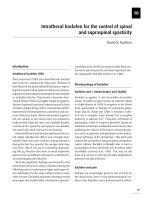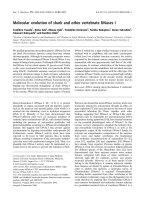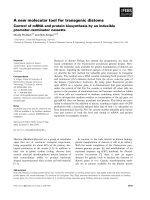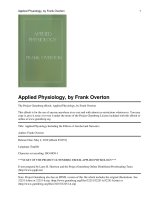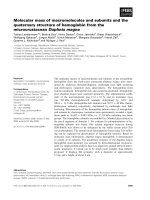Molecular control of adipogenesis and obesity potx
Bạn đang xem bản rút gọn của tài liệu. Xem và tải ngay bản đầy đủ của tài liệu tại đây (59.2 KB, 3 trang )
Genome Biology 2004, 5:327
comment
reviews
reports
deposited research
interactions
information
refereed research
Meeting report
A burst of energy in metabolic disease research
Jaswinder K Sethi
Address: Department of Clinical Biochemistry, University of Cambridge, Addenbrooke’s Hospital, Hills Road, Cambridge CB2 2QR, UK.
E-mail:
Published: 27 May 2004
Genome Biology 2004, 5:327
The electronic version of this article is the complete one and can be
found online at />© 2004 BioMed Central Ltd
A report on the ‘Diabetes Mellitus’ and ‘Adipogenesis and
Obesity’ joint Keystone Symposia, Banff, Canada, 4-10
March 2004.
The genomic era has injected a fresh burst of energy into
the study of complex metabolic diseases. Over 900 dele-
gates congregated at the foothills of the Rockies in Banff,
Canada to learn about the latest developments in research
into obesity and the commonly associated disorder, type 2
diabetes mellitus. Allen Spiegel (National Institute of Dia-
betes and Digestive and Kidney Diseases, National Insti-
tutes of Health, Bethesda, USA) kicked off the line up and
introduced the major initiatives that the National Insti-
tutes of Health (NIH) have recently established to support
diabetes and obesity research. These include the establish-
ment of large-scale, multidisciplinary, collaborative efforts
that combine and coordinate information generated from
genomics, proteomics, stem-cell biology and bioinformat-
ics. In particular, members of the following consortia
were well represented by the speakers at the meeting: the
Beta Cell Biology Consortium and Endocrine Pancreas
Consortium [ the
Diabetes Genome Anatomy Project [-
betesgenome.org]; the Nuclear Receptor Signaling Atlas
[] and the Mouse Metabolic Pheno-
typing Centers []. Other initiatives
that are clearly beginning to make an impact on diabetes
and obesity research include the identification of obesity
genes in invertebrates, and interdisciplinary research bridg-
ing neurobiology and behavioral science. Some of the major
new developments that dominated the conference stemmed
from these initiatives and are discussed in this report. It was
refreshing, however, to note that these collaborative efforts
were not limited to US-based research groups and often
appear to be truly global collaborations.
Molecular control of adipogenesis and obesity
Gary Ruvkun (Harvard Medical School, Boston, USA) high-
lighted the fact that important lessons for human disease
can be learnt from the biology of invertebrates. He and his
colleagues have used genome-wide RNA interference (RNAi)
to identify genes involved in fat deposition in Caenorhabdi-
tis elegans. Although these worms do not have a defined
adipose-like tissue, they do accumulate triglycerides in iden-
tifiable depots in response to nutritional and environmental
cues. Indeed, there are evolutionary ancient mechanisms to
regulate feeding and fat storage, even in these simple organ-
isms. Of the 16,757 genes Ruvkun and co-workers sup-
pressed by RNAi, inactivation of 261 led to reduced fat
accumulation but was also accompanied by larval arrest,
embryonic lethality or sterility, so these genes were not
studied further. The team was able to identify 305 genes
whose inactivation reduced body fat content and 112 that led
to increased fat storage; all of these sequences are available
at Wormbase []. Many of these
fat-regulating genes have mammalian homologs that have
already been implicated in fat metabolism and storage.
Approximately 150 have not previously been linked to fat
biology in mammals, however. Hence, Ruvkun and col-
leagues have identified 150 potentially novel mammalian
targets for regulating triglyceride storage.
Also looking at evolutionarily common ancestors, Gökhan
Hotamisligil (Harvard School of Public Health, Boston,
USA) reminded attendees that the geneticist’s favorite
subject, the fruit fly Drosophila, has a rudimentary fat body
that has many parallels with mammalian adipose tissue. The
fact that the fat body plays a major role in host defense and
immune function has provided a novel perspective of the
biological functions of mammalian adipose tissue. The func-
tional parallels in immune biology and energy metabolism
were further echoed in talks by Stuart Weisberg (Columbia
University, New York, USA) and Steven Shoelson (Joslin
Diabetes Center, Boston, USA). Weisberg described how
adipose-tissue expression profiles from various models of
adiposity led him and his colleagues to the finding that
adipose tissue from obese rodents and human subjects not
only carries the hallmarks of an ‘inflamed’ organ, but is also
infiltrated by bone-marrow derived macrophages. Further-
more, macrophages are also present in adipose depots that
coat skeletal muscle. Weisberg postulated that these cells
might be the most likely source of the key inflammatory
cytokines that have been linked to obesity-related insulin
resistance. Previous work by Shoelson and others has impli-
cated inhibitor of kappaB kinase  (IKK) in mediating
cytokine-induced insulin resistance. To further identify the
tissues in which IKK activity could be relevant, Shoelson
has generated a new series of tissue-specific, genetically
modified murine models. Preliminary phenotyping and
expression profiling appears to suggest that the liver and
adipose tissue are involved in the insulin-sensitizing effects
of IKK inhibition in vivo, but the  cells and skeletal
muscle show little change. Could the liver and adipose tissue
be the organs in which the immune system impacts on
insulin sensitivity in obese diabetics?
Diabetes mellitus: molecular signaling, genes
and therapeutics
The pathophysiology of the common polygenic form of type
2 diabetes results from early onset insulin resistance coupled
with functional defects in insulin secretion by pancreatic
islet  cells. Islet transplantations offer a potentially valuable
therapeutic approach for the treatment of diabetes, but sig-
nificant obstacles must be overcome to combat the shortage
of islet tissue. This requires a greater understanding of the
ontogeny of the endocrine pancreas. Only then will it be pos-
sible to isolate the appropriate progenitor cells, and to
expand and differentiate them in vitro prior to transplanta-
tion. To this end, the Endocrine Pancreas Consortium and
the Beta Cell Biology Consortium were established. Klaus
Kaestner (University of Pennsylvania, Philadelphia, USA)
presented the tremendous progress that has been made
towards constructing and sequencing cDNA libraries that
are enriched in rare transcripts expressed during pancreatic
development. The figures currently stand at 15 mouse cDNA
libraries containing more than 70,000 transcripts, and seven
human libraries containing more than 110,000 transcripts.
Kaestner’s group has used cluster analysis to identify
approximately 14,000 representative expressed sequence
tags (ESTs) from these libraries, and has then used these to
make the ‘PancChip’ microarray. Kaestner reported that
version 5.0 of this chip is now available from the Endocrine
Pancreas Consortium, and the first human pancreas
microarray, termed hPancChip1.0, is also being developed.
Using a different approach, Duncan Odom (Whitehead Insti-
tute/Massachusetts Institute of Technology, Cambridge,
USA) combined the power of genome-wide promoter arrays
and chromatin immunoprecipitation (ChIP) systematically
to identify the genes in human liver and pancreatic islets
that are directly regulated by the transcriptional regulators
HNF1␣, HNF4␣ and HNF6 and transcribed by RNA poly-
merase II. In so doing, his group has dissected the tissue-
specific regulatory networks orchestrated by the three
transcription factors in both liver and pancreas develop-
ment. The model they obtained provides a plausible mecha-
nism for the less common form of diabetes that is caused by
HNF4␣ deregulation.
Another computational approach was taken by the Beta Cell
Biology Consortium to identify several hundred human cell-
surface antigens that may allow the detection of progenitor
pancreatic cells. These antigens are currently being used by
the Consortium for conventional and genetic immunization
to create a new collection of antisera that will be made avail-
able (within the next year), for further characterization by
the community. These new developments are set to substan-
tially increase our understanding of the ontogeny of the
endocrine pancreas.
Insulin resistance and type 2 diabetes - a problem in
the power plant
Previously, researchers hypothesized that mitochondrial
dysfunction in insulin-target tissues might be correlated
with the common form of human type 2 diabetes, but this
could not be attributed to the deregulated expression of a
single gene. This conclusion was re-iterated by two speakers:
Vamsi Mootha (Broad Institute, Cambridge, USA) and
Mary-Elizabeth Patti (Joslin Diabetes Center, Boston, USA),
who described their independent studies of the differential
expression profiles of control, prediabetic and diabetic
human skeletal muscle. Reasoning that the differential
expression of groups of related genes might be co-ordinately
altered in diabetic muscle, both groups tested this hypothe-
sis using novel, innovative computational approaches
together with publicly available gene-ontology lists.
Mootha and colleagues developed an iterative statistical
approach they called gene set enrichment analysis (GSEA),
which uses previously defined gene sets - based on biological
pathways - to increase the signal relative to noise, and to
improve the statistical power of any observed changes. In
contrast, Patti and colleagues annotated their data using
programs such as GeneSpring (from Silicon Genetics Inc.),
UnCHIP (from Harvard University, USA) and Onto-Express
(from Wayne State University, Detroit, USA). They then
used GenMAPP, MaPPFinder (both from the Gladstone
Institutes, University of California, San Francisco, USA) and
Onto-Express to integrate the expression data with known
pathways, and to determine confidence levels for differential
expression within ontology groups. The highest scoring gene
sets contained many genes that are members of the mito-
chondrial oxidative phosphorylation pathway; all of these
oxidative phosphoryation genes showed a modest but con-
sistent decrease in expression in diabetic tissue, and it seems
327.2 Genome Biology 2004, Volume 5, Issue 6, Article 327 Sethi />Genome Biology 2004, 5:327
that a subset is co-regulated across many tissues and highly
expressed in insulin-responsive, glucose-disposal tissues.
Using motifADE - a generic tool that combines gene-expres-
sion patterns with promoter analysis - Mootha and colleagues
were able to hypothesize the identity of key regulators in this
transcriptional network. Subsequent experimental evidence
from more traditional molecular and pharmacological
approaches confirmed that these players are, in fact, nuclear
respiratory factor-1 (NRF-1) interacting with peroxisome
proliferation-activated receptor-␥ (PPAR-␥) coactivator-1
(PGC1␣) to co-regulate estrogen-related receptor ␣ (ERR␣)
and GA-repeat binding protein ␣ (GABP␣). Together these
factors control the expression of the oxidative phosphoryla-
tion genes. Patti and colleagues also found that expression of
NRF-1 was reduced in diabetic subjects only, but the expres-
sion of PGC1␣ and PGC1 was decreased in both diabetic
and pre-diabetic subjects, a finding that suggests that they
may be good candidates for diagnosing an individual’s risk
of developing type 2 diabetes.
The role of proper mitochondrial function in insulin action
may not be limited to skeletal muscle. Evidence presented
by Silvia Corvera (University of Massachusetts Medical
School, Worcester, USA) supported this notion by demon-
strating that mitochondrial biogenesis and remodeling
occurs during adipose tissue development. She also sug-
gested that mitochondria might play a major role during the
development of obesity and in the actions of the insulin sen-
sitizer rosiglitazone.
Signaling pathways and diabetes
To identify novel candidate proteins that may be involved in
the signals that regulate insulin-sensitive glucose uptake,
Michael Czech (University of Massachusetts Medical School,
Worcester, USA) and co-workers have looked at differential
expression of genes in insulin-sensitive compared to insulin-
resistant states, as well as of genes that are selectively
expressed in differentiated adipocytes and muscle, the two
principle tissues in which insulin stimulates glucose uptake.
In addition, he has taken a proteomic approach to identify
proteins that are intimately associated with vesicles contain-
ing the insulin-responsive glucose transporter-4 (Glut4) or
with the signaling serine/threonine protein kinase B (also
known as Akt). Complementing these approaches with gene
silencing by RNAi, Czech’s group has unveiled 200 candidate
proteins including some previously known suspects, such as
the receptor interacting protein RIP140. The novel candidate
proteins that were mentioned in Czech’s talk include WNK1, a
protein kinase involved in ion transport in the kidney, an exo-
cytosis-related protein, EHD1, and a SNARE protein involved
in the control of synaptic vesicle fusion.
Czech also described his use of RNAi technology to system-
atically knock-down key signaling molecules and screen for
their requirement in insulin-stimulated glucose uptake in an
in vitro adipocyte model system (3T3-L1 cells). To date, two
pathways have been postulated to mediate insulin-stimu-
lated glucose uptake: the conventional phosphatidylinositol
3-kinase/protein kinase B (PI3K/PKB)-dependent pathway,
which may recruit downstream effectors such as protein
kinase C (PKC) and ; and the novel CAP-Cbl-Crk-TC10
pathway, which is independent of PI3K activity. Both path-
ways are activated by insulin receptor tyrosine kinase and
perturbations have been shown to modify insulin-stimulated
Glut4 translocation. Using specific gene inactivation, Czech's
group could not demonstrate a requirement for the CAP-
Cbl-Crk TC10 pathway or signals dependent on PKC and
. Instead, they have found that both Akt1 and Akt2 are
absolutely required for normal insulin-stimulated glucose
transport, with Akt2 playing a predominant role. That Akt2
is also relevant to human diabetes was emphasized by
Stephen O’Rahilly (Cambridge University, UK), who
announced the discovery of a naturally occurring, but rare,
dominant-negative mutation in the human Akt2 gene. This
mutation was associated with a dominantly inherited form
of severe insulin resistance. It is the first example of an
inherited gene defect in a post-receptor signaling molecule
causing human diabetes and was identified from the group’s
severe insulin resistance (SIR) cohort (now numbering 250
subjects). These reports now firmly establish a role for Akt2
in normal insulin-stimulated glucose uptake.
In conclusion, the past few years have seen an avalanche of
new technologies being successfully applied to understand-
ing complex disease states such as obesity and diabetes.
Transgenics and knockout mouse technology has now been
joined by transcriptomics, proteomics and genome-wide
RNAi, all of which, when coordinated, are proving to be very
powerful research approaches. Good times are indeed ahead
for obesity and diabetes research as the way is being paved
for multidisciplinary approaches to uncover the underlying
causes of these multi-factorial diseases. Abstract books from
the meeting can be ordered online from [-
stonesymposia.org]
Acknowledgements
J.K.S. is supported by a BBSRC David Phillips Fellowship.
comment
reviews
reports
deposited research
interactions
information
refereed research
Genome Biology 2004, Volume 5, Issue 6, Article 327 Sethi 327.3
Genome Biology 2004, 5:327
